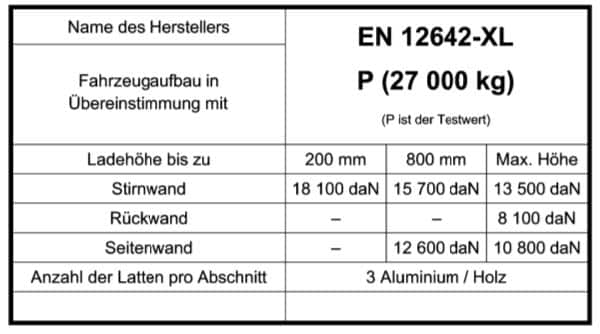
Now 10% off all Ergolash lashing straps save now! Voucher code: ergo10 | Valid until 31.05.2025
The Code XL body, the magic word in load securing. Quite a few shippers and drivers are of the opinion that now only loading and no more securing is required.
This is only partly true. The wise answer is: “It depends”. On what?

The European standard with the unwieldy title:
EN-12642 “Load securing on road vehicles – Superstructures on commercial vehicles – Minimum requirements” is actually a test specification for superstructures.
Regardless of how the structure is technically designed, it must:

These forces must be tested and verified either statically or dynamically as part of road tests. The structure may deform elastically up to 300 mm. A permanent deformation of a maximum of 20 mm is permissible, provided the function is not impaired.
The latest edition explicitly states that the verified forces may also be used for calculating load securing. This was not the case in previous editions, although most shippers have kept it that way.
Proof of this test is usually provided in the form of a certificate, in which the manufacturer also sets out the boundary conditions under which the body can be used for load securing. It is also stipulated that the body must be inspected annually by experts for suitability. The certificate also states the technical payload and the chassis number to which it relates.
Most manufacturers describe the following boundary conditions for load securing via the body in their certificates:
The standard obliges manufacturers to mark their vehicles with a label that provides the shipper/driver with the most important information about body strength.
The figures are manufacturer-specific and body-related.

Unfortunately, some manufacturers do not implement this in a compliant manner, but design it differently and do not install it in the recommended place. Irrespective of the manufacturer’s labeling obligation, the shipper should ensure that the driver has the certificate to hand.
The certificate usually also contains a Solomonic note from the manufacturer stating that additional securing measures must be taken in accordance with VDI-2700ff “Load securing on road vehicles” in the event of deviating conditions.
In practice, however, it is often unclear how the boundary conditions should be implemented. This is usually because the load does not fit on the vehicle as well as some people would like. Causes can be:

Due to the load distribution, the load must be placed towards the rear. An upright Euro pallet was installed as a spacer. It acts like a can opener.

This is the result of an unsuitable spacer. The bulkhead was pushed out forwards during braking.

This is what the body looks like when the load has moved. It lies on the right in the tarpaulin and bends the upper roof beams. This can be seen particularly clearly on the left-hand roof rack.

If loaded incorrectly, the bulkhead cannot hold the load either.
(Source: KLSK; Photo-of-the-Month 2016-03)

As soon as the load width falls below 2.40 m, the load must be secured.
Whether simple lashing down is sufficient in this case is questionable. No anti-slip mats were used and the belt runs over the unstable loading flap of the pallet cage.
If there are significant incidents (e.g. due to damage to the body) with the load securing, the shipper is required to provide evidence of how he has assessed the body and what conclusions he has drawn from this.
You should never rely on statements from drivers such as “it will hold”. In critical cases, rejecting the load is the safest decision.
The next issue of the LaSi blog will describe types of cargo that are likely to cause problems and what measures can be taken.
Yours, Sigurd Ehringer
Next article >>
Episode 33: Problem treatments – using blocking agents correctly

Sigurd Ehringer
✔ VDI-zertifizierter Ausbilder für Ladungssicherung ✔ Fachbuch-Autor ✔ 8 Jahre Projektmanager ✔ 12 Jahre bei der Bundeswehr (Kompaniechef) ✔ 20 Jahre Vertriebserfahrung ✔ seit 1996 Berater/Ausbilder in der Logistik ✔ 44 Jahre Ausbilder/Trainer in verschiedenen Bereichen —> In einer Reihe von Fachbeiträgen aus der Praxis, zu Themen rund um den Container und LKW, erhalten Sie Profiwissen aus erster Hand. Wie sichert man Ladung korrekt und was sind die Grundlagen der Ladungssicherung? Erarbeitet und vorgestellt werden sie von Sigurd Ehringer, Inhaber von SE-LogCon.
Rothschenk assortment
Our customer center has only one goal: to turn your problems into solutions. Whether standard stowage cushions, bestsellers or load securing personally tailored to your needs -. we accompany you consistently from A as in field service to Z as in certification. That is our promise to you, as a leader in our industry.
We attach great importance to professional cargo securing. That is why we have our own production, which ensures reliable operation through modern manufacturing technologies and strict quality control. Thus, we offer our customers a comprehensive and high-quality range of services in the field of transport logistics.
DIN ISO 9001:2015, EMAS and Ecovadis are not foreign words to you? Then it's time to work with the best.
You don't take any risks with us - we have been awarded the Platinum Medal on the EcoVadis sustainability rating platform.
As a load securement company, we are proud to have several certifications that validate our sustainability efforts and our commitment to environmental protection and social responsibility. For you as a purchaser, this means that we demand and promote the implementation of high environmental and social standards both within the company and along the supply chain.
You are currently viewing a placeholder content from Google Maps. To access the actual content, click the button below. Please note that doing so will share data with third-party providers.
More Information